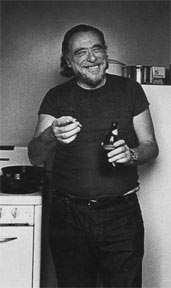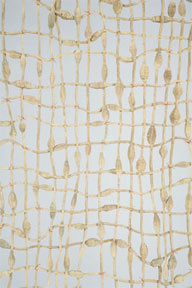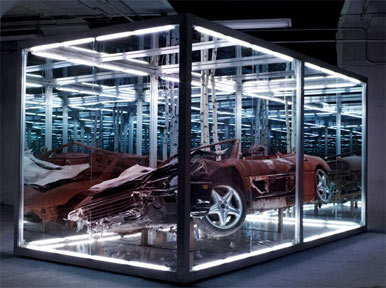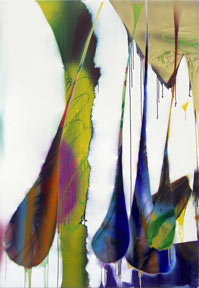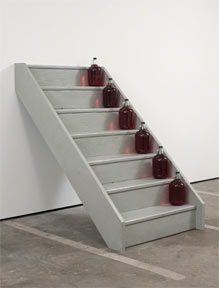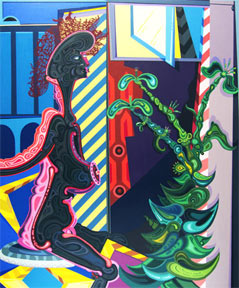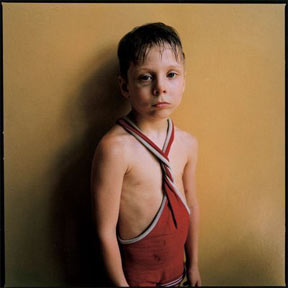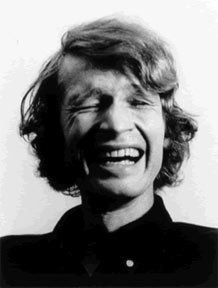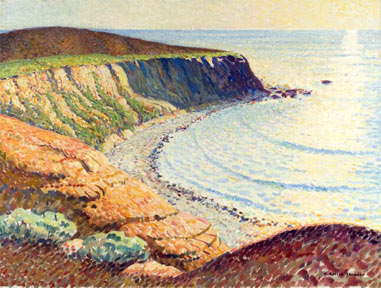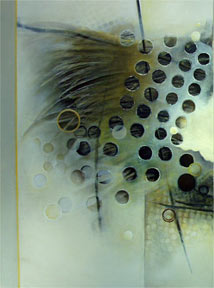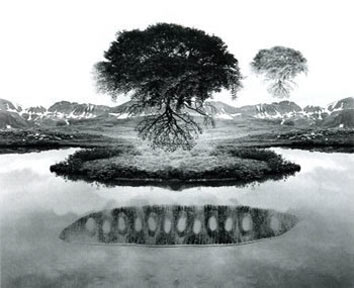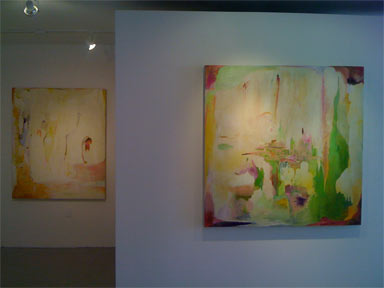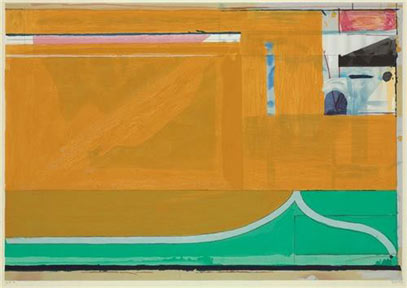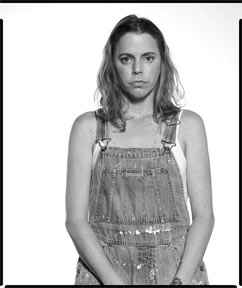| CONTINUING AND RECOMMENDED EXHIBITIONS, DECEMBER, 2010 |
|
Carol Es, "Too Much Under the Bridge," 2010, oil, paper, patterns, thread, embroidery on linen, 40 x 60". Carols Es' drawings and paintings have a childlike simplicity yet while the articulation is pared down, the content is not. Titled "It's Mostly About Me and Much Less About You" this body of work draws from Es's life, using characters from her family as well as her work in the apparel industry. The multimedia works include pencil, paint, embroidery and swatches of fabric woven together to create narratives in which the individual grapple with the struggles of life. Es' characters have exaggerated features and not much detail, but their expressions and gestures are poignant commentaries on today's economic, social and political climate. Using vivid colors, Es comments on both fashion and the urban landscape, routinely collapsing fantasy and reality. Her new works solidify that through a developed personal vocabulary of mark-making even the simplest gestures can resonate (George Billis Gallery, Culver City).
Author Charles Bukowski Trine Ellitsgaard, "Red," 2009, braided palm leaves and horse hair, 51 x 38".
Martin Mull, "Comedian," 2010, oil on linen, 29 x 90". Although you may know him as Roseanne's gay boss or the voice of Father Donovan on American Dad, Martin Mull was actually an artist long before he ever made it to the screen, and from the looks of his new show, "Split Infinitives," he spends at least as much energy on his paintings as he does on being a funny guy. The paintings are not so funny - "Comedian" is a black and white oil on linen of a man hunched over watching TV; behind him a woman is lying on a low bed with an arm thrown over her eyes like something hurts. Like the photo it was taken from, the man's face is a blaze of white TV reflection. Not surprisingly, Mull tweaks and reconstructs the idea of a Hollywood set by constructing his not-quite-seamless content using bits and pieces of photographs gleaned from found and personal sources. Like grimly detailed storyboards, the implication of narrative adds suspense, but it is the relationship between the men and women in each work that really provokes (Samuel Freeman, Santa Monica).
Anthony James, "KT," 2008, wrecked Ferrari 355 Spider, birch, florescent lights. British artist Anthony James' "?T" is a tour de force sculpture. It consists of the purposely charred remains of the artist's Ferrari 355 Spider, housed in a one-way-mirrored steel and glass vitrine, along with a few birch tree trunk segments from the same forest where the car was set afire, in Kingston, New York. "?T" stands for kalos thanatos, ancient Greek for "beautiful death." While of course bearing the inevitable stamp of Damien Hirst (what large, rectangular, glass-encased object could possibly evade such a comparison?), the work presents a substantially different kind of experience. As aestheticized as the presentation is - down to the deep-space, near infinite reflections from the interior, one-way mirrors - the work is equally tied up in both memorial and process. The rusted remains can't help but circle one back to a performance unseen. That the genesis of the project derives from a reaction to 9/11 is a tough nut to crack - or pill to swallow - but it's no stretch at all to accept that the gesture is an act of sacrifice. Over in the East gallery, the smaller, similarly lit vitrines (with fluorescent tubes lining the inner corners) are filled with mini-birch forests, and at least by comparison to the central work, feel relatively precious. Perhaps too much nature for their own good (Patrick Painter Gallery, Santa Monica).
My Barbarian, "The Night Epi$0de Two: Yoga Matt," 2009, single-channel video still. In their first U.S. solo museum exhibition the Los Angeles collective My Barbarian (Malik Gaines, Jade Gordon and Alexandro Segade) create an installation that combines props, projection and short videos presented on monitors. They have expanded the focus of their work to move from screen to screen rather than being limited to a single projection. Their project, titled "The Night Epi$ode," is an investigation into the powers of art, the intricacies of the art world, and the struggles of those hit by the economic crisis confronting contemporary society. This is impeccably crafted social commentary. Conceived as an installation rather than as a performance or single narrative, the work allows for multiple points of entry and stylistic experiments that multiple perspectives and interpretive options (Hammer Museum, West Los Angeles).
Katharina Grosse, "Untitled (KG/M 2010_1013L)," 2010, acrylic on canvas, 84 x 58".
Katharina Grosse's newest paintings look like reverse graffiti. The graffiti part should come as no surprise to anybody who has seen her spray-painted bedroom or any of her other ephemeral color field installations, which look like nothing so much as a whirling dervish gone painting with a spray gun and an ecstatic dance. In light of her past, this show looks remarkably contained; all the canvases are large upright rectangles with white blank space dominating the content of many of the works. That said, the color, which was apparently sprayed on top of stencils, runs and drips with such vigor that even from the cracks and creases of the painting the background threatens to take over the foreground. Indeed, the condensed vitality of the mess of colors swarming in the "negative space" ties the question of foreground and background into a pretzel (Christopher Grimes Gallery, Santa Monica).
Augusta Wood, "Downstairs (1985, 1991, 1999, 2008)," 2009, chromogenic print, 29 3/4 x 39". "I have only what I remember" is a surprisingly beautiful show of crisp color photos made from interior projections in Augusta Wood's grandparents' former home. Wood projected slides spanning over five decades - from the '60s to the present - on walls throughout the now empty rooms, combining anywhere from two up to six slide projections per chromogenic print. Wood's grandparents were both painters themselves, and so it's appropriate that one of the most visually complex photos (though each image delivers its own caliber of complexity), "Downstairs (1985, 1991, 1999, 2008)" appears to feature the former layout of the painters' studio recreated on the walls of the same space. There are separate projections of the couples' painting storage racks, one of them set into the very same formerly active alcove at the end of a black-and-white-tiled floor. It's a mesmerizing image, as is "To The River (2002, 2006, 2008)," which brings the outside in. In mixing and matching vintage images and making them the stars of their own photographs, Wood manages to both summon and dispense with nostalgia simultaneously (Angles Gallery, Culver City).
Amanda Ross-Ho, "Six Jugs of Blush," 2010, Carlo Rossi Blush, wood, enamel paint, acrylic paint, 66 1/2 x 43 1/2 x 61 1/2". In her current exhibition Amanda Ross-Ho pushes at the boundaries of the conceptual and visual. The press release for the show functions as one of the exhibition's works. Most of the text has been crossed out, leaving choice words highlighted in red. It becomes a way into the exhibition as well as a souvenir. The exhibition that unfolds is self-referential, as it presents fragments from Ross-Ho's daily existence - bits and pieces of notes and scribbles - that formally relates to the red used to design the press release-cum-art. The works hang on the walls and cover the floor. They are connected by shape and color, and require the viewer to figure out what they mean and why they are presented together. Ross-Ho is an enigma by virtue of the fact that her work is deliberately obtuse (Cherry & Martin Gallery, Culver City).
Erik Parker, "Untitled (Character Defects)," 2010, acrylic and gouache on canvas, 65 x 54". While Erik Parker and Andy Warhol have would seem to have little in common, seeing their side-by-side exhibitions highlights formal similarities. Warhol's camouflage paintings have rarely been seen in Los Angeles, and this exhibition allows viewers to see the range of these works, which were created in the mid-1980s. Warhol used a colorful palette and manipulated the traditional pattern to create abstract works in a myriad of sizes. Parker is as much of a colorist as Warhol was, although his subject matter is not derived from popular culture, but rather from the history of art. He paints still lifes, nudes and landscapes that emphasize aggressively bright, saturated colors (Honor Fraser, Culver City).
Laurie Hogin, "American Habitat Diorama: Silver Bullets in the Garden of St. Augustine", 2010, oil on canvas, 72" x 96". Laurie Hogin makes humorously sinister paintings that fuse fact and fantasy. She is an exceptionally talented painter, who can render anything in exacting detail. In her current exhibition "Stories of Love and Hunger from the Candy Planet," animals, plants, fruits and vegetables coexist in invented environments. In Hogin's work everything is exaggerated and hyper-real. Hogin sees her painted world as a metaphor for our current cultural context, "one in which free markets promise stories, experience, images and commodities to fill every conceivable human need and desire from the most basic to the weirdest and darkest." The paintings, ranging in size from just a few inches to human scale depict mutant forms that glare out at the viewer, baring their teeth and inviting debate. The works are simultaneously precious, seductive and disturbing (Koplin Del Rio Gallery, Culver City).
Darren Hostetter, "Clusterfubar 1," 2010, acrylic on aircraft aluminum, 12 x 12".
Michal Chelbin, "Black Eye, Ukraine," 2006, chromogenic print, 37 x 37". A show featuring the photographic works of Israeli artist Michal Chelbin and California-based photographer Hugh Holland present disparate visions of childhood, athleticism, and homosocial experiences. In "Locals Only" Holland's color photographs document skateboarding culture in the mid-seventies, specifically the days of Dogtown in Venice, California where skateboarding was an extension of surfing and not yet a commercial sport. "Locals Only" captures the renegade spirit of local skaters who trespassed into backyards to defy gravity in empty swimming pools and smoked grass on the sidelines. "Down on the Corner, Danny Kwok, Balboa Beach" celebrates a moment when young Kwok is lost in the bliss of skating on asphalt. Barefoot and bare-chested, his pre-adolescent physique is low to the ground as if it were gliding on invisible beads of water. While the boys of Z Town seem blissfully unaware of the camera, the European athletes of professional wrestling schools in "Black Eye" are acutely aware of its presence. They awkwardly pose in unitards that accentuate every part of their developing form. "Black Eye Ukraine" depicts a small boy who couldn't be much more than ten years old, his unitard straps twisted in a knot on the front of his chest. He stares directly into the lens despite his blackened right eye. Chelbin's subjects range from pre-pubescent to mature males, as seen in "Llya, Ukraine' who seems proud of his chiseled chest as it straddles his waist. While wrestling is an age-old sport, the series chronicles a European ethos and expectation of boys to fight and wear it as a badge of masculinity. It makes skateboarding seem an act of child's play (M+B Fine Art, West Hollywood).
Bas Jan Ader, "I Am Too Sad to Tell You," 1971, still from 16mm film. As a quirky homage to his fellow Dutch artist Piet Mondrian, Bas Jan Ader documented one of his now iconic "falls" in the shadow of the Westkapelle lighthouse. Titled "Study for On the Road to a new Neo Plasticism, Westkapelle, Holland," Jan Ader is depicted as forming the black grid, face down, artfully incorporated into blocks of primary colors. This early work underpins the impetus for much of Jan Ader's project: admiration, aspiration, and the probability of failure. In "Untitled (Swedish Fall)" the artist falling in a forest alludes to his father - a resistance fighter and war hero - who was murdered in a similar locale by Nazi forces. Jan Ader's final unfinished piece, attempting a solo voyage across the Atlantic in a boat barely twelve feet long - and his tragic disappearance in the North Atlantic - is exhibited along with works by other artists subsequently affected by Jan Ader's brief but affecting career (Pitzer College Art Galleries, Claremont). Titled "Hidden Places," the multi media work of South African-born painter Daniel du Plessis is subtle and complicated storytelling expressed through meticulously detailed and flawlessly executed depictions of flora and fauna, and metamorphoses of both. Du Plessis uses beauty to tell dark, disturbing stories of love found and lost, lust gone to dust and, above all, the ephemeral nature of all living things. To uncover the dark side of everything pretty and romantic, he spares neither mediums nor effort. For example, in "We Can Take, But ..." Du Plessis painted a set of old, bony hands holding a delicate bird's nest in meticulous detail that relates to late medieval illuminated manuscripts. Then again, due to numerous layers of applied paint, the painting is so luminous as to seem supernatural, a page from a sorcerers manual. For this and other works, he has built an elaborate mat/frame combination that contains countless replicas of bugs, butterflies, shells and other critters that he either formed from apoxy clay or bought/found and applied to the composition. The effect is one of a stage play, with the foreground evoking the main plot and the frame providing the back story, deepening the riddle rather than solving it. Flowers, tiny skulls and miniature toy animals painted a dark brown remind one of the narrow division between life and death. "Butterfly Nebula," an assemblage of 25 acrylic, mixed media and resin on aluminum on wood panels completed this year, reveals what might be a departure from du Plessis' obsessively detailed representation. It makes me wonder if he might have seen what fascinates so many filmmakers, namely the world beyond - whatever that may be (Huntington Beach Fine Art Center, Orange County). Daniella Walsh
E. Roscoe Shrader, "Palos Verdes Coast," oil on canvas, 30 x 40". Being a Southern Californian artist and well removed from the European source of Post-Impressionism of the late 19th century, E. Roscoe Shrader, throughout the first half of the 20th century, was free to appropriate the style, but by his own rules. He was a local leader in the arts, serving as President of the California Art Club and, for 30 years (1919-49) was an influential art teacher at Otis Art Institute. Unlike the Post-Impressionist masters, who opened the door to modern abstraction, Shrader did not seek to create formal compositions, geometric constructs, or to build an image plane by plane. Rather, Shrader sure-handedly painted directly with little or no preliminary drawing on the canvas, whether a figurative image, a still life, or a landscape. The free spirit that is conveyed can also be attributed to his skill in seeing the whole composition before completion. What remains of the Post-Impressionist source is how his colors sing, shimmer with dazzling light, and are drenched in romanticism. Thus, Shrader's art leans more towards the highly emotive. Shrader's paintings were formed with individual freely-made yet, expertly controlled broad gestural brushstrokes. The artist continuously must have been captivated by the wonder and beauty surrounding him. As to why this wonderful painter has been obscured with time, he gave away much of his art to friends and loved ones. In this way Shrader narrowed his circle of collectors and reined in any possibility of fame. Despite his impracticality, this exhibition reveals an exceptional body of work worthy of fresh consideration (Laguna Museum of Art, Orange County).
Olga Sinclair, "Untitled 1," 2010, oil on canvas, 41 x 25". Passion is immediately visible in the canvasses of Panamanian artist Olga Sinclair. Sinclair is clearly a colorist and uses paint brilliantly. The title of the exhibition is "Saturation," and the paint soaks into the canvas from watery thin to impassionedly thick tones. Her palette is largely composed of luscious colors: imperial purple, violet, sable, fuchsia, crimson, and candy apple green. Each of her robust still lifes, of over-sized and sensual fruit, are composed of multiple voices that interact simultaneously. Using broad sweeping strokes with those saturated colors, Sinclair forms enormous, overlapping planes alternate between transparency and opacity. This allows us to see through the layers of a painting, as if looking through glass. For added sensuality Sinclair drips paint, some ribbon-like, that seem to flow spontaneously, as if it knows just where to go. Then Sinclair draws powerful lines that intersect the picture plane in several directions, straight and crossed, giving the canvas an even greater sense of voluminous space. The lines knife through the various planes of the painting, increasing the distance from foreground to background, and adding a haunting rhythm to the visual chorus (Salt Fine Art, Orange County).
Chiyomi Taneike Longo, "White Passage #47," charcoal, acrylic, oil on panel #1 of tryptich, 40 x 30". Al Longo and Chiyomi Taneike Longo work individually, but their dialoguing works reflect the dynamic of a married couple. While each artist has exhibited alone and together in group shows, this is the first time exhibiting side by side. The show depicts the symbiotic world of creative soul mates who have painted together for 45 years. It is clear that they have profoundly influenced each other's spiritually oriented abstract works with strong references from nature, Japanese artistry and symbols. Chiyomi, working with charcoal, acrylics, sumi inks and oils, instills works with natural figures, particularly trees, and biomorphic forms. Each painting, including selections from the "White Passage" and "Seed of the Mind" series, has movement, some with multiple panels for each, telling stories of the passage of time, of musical arrangements and of the fusion of light and dark, yin and yang. Using a palette of blacks, grays and light colors, with soft black lines of charcoal and of strong black lines and large splotches from sumi ink, there is a strong presence of calligraphy. Al's paintings, mostly oils, with collage elements of Japanese wrapping paper, some on shaped canvasses, are more vividly colorful and masculine with bold, fluid shapes filling the canvasses. The abstract shapes are comfortable on the eye, influenced by natural elements seen through a microscope. "Inner Landscape 1-5 #2," the boldest work here, is a large, vibrantly colored oil and collage of scenery along the 1-5 freeway, abstractly depicting roads, trees, mountains and sky (Marion Meyer Contemporary Art, Laguna Beach).
Jerry Uelsmann, "Untitled," 1969, gelatin silver print. Husband-and-wife exhibitions are unusual, but not so this month. For Jerry Uelsmann and Maggie Taylor, partners in art and in life, the pairing yields the ideal perspective for viewing each other's work. Both artists build composite images. Uelsmann uses the darkroom, moving the image from enlarger to enlarger, to create his black-and-white, gelatin silver prints. Taylor uses the scanner and computer to produce her color - sometimes it is eye-popping - pigment prints. Despite these differences, the similarity in their work extends beyond the sharing of parts of images. A certain tree, a pile of rocks, or a ladder, for instance. Their parallel sensibility is particularly evident in four pieces displayed together: two of Taylor's "Alice-in-Wonderland" pieces (2006), and Uelsmann's "The Long Now" (2005) and an untitled piece (1997). The narrative flows between these pieces because of the works' common sense of isolation and timelessness with a surrealistic tinge. Also on view are "Reflections: Exploring Cultural Identity," "In Light: Selections from the Permanent Collection," and "Seeing Beauty" (Museum of Photographic Arts, San Diego).
Joshua Elias, installation view of "The Golden Thread".
Richard Diebenkorn, "Ochre," 1983, painting, wood block print, 25 x 37 1/2". The theme that pulls this group show together is how individual artists portray their "Perspectives on Reality." To George McNeill, Reality is expressed with vivid colors, motion, energy, and the joy of being alive. Painted on a large canvas that embraces the viewer, the overlapping figures playfully bounce around the scene, one figure merging into another, and in the most child-like and delicious colors. Photographer Jean-Francois Rauzier has developed a collage technique in which he stitches together up to 50 pictures into a single image. In a large Chromogenic print of a believable, yet impossible home, he traps us with his 50 perspective points. Our eyes continually move through the scene, as we look for a way out, a restful space; but instead, we discover yet another object or person. Rauzier draws us into the visual space of the home using both perspective and mirrors upon mirrors. The eye cannot help but wander up and down, in and around, continuously coming upon hidden stories in this compelling, yet claustrophobically surreal image. John Paul Jones, who is currently featured in several venues, is represented here with "The Rose Queen's Mirror," a wood and copper wall sculpture where the viewer becomes part of the reflection in a ghostly frozen moment. Being who he is, the work is sensitively crafted with both flatness and dimensionality, just enough to captivate the viewer who finds his image staring back from a darkened copper field. Reality becomes whoever peers at the sculpture. Richard Diebenkorn's woodblock print shows his unique Reality expressed in his Ocean Park series. It's a geometric world of exquisitely formed blocks of abstract space and shapes, presented in vivid colors that portray the world in its purest form (Art Resource Group, Orange County).
Joe Sorren, "Interruption," 2009-10, oil on linen.
Dean DeCocker, "Black Tide," 2010, acrylic paint, cardboard, metal powder coat, 26 x 17 x 16".
Amy Bystedt and Sally Egan, "Richard Avedon" from "Hats Off," photograph. |





